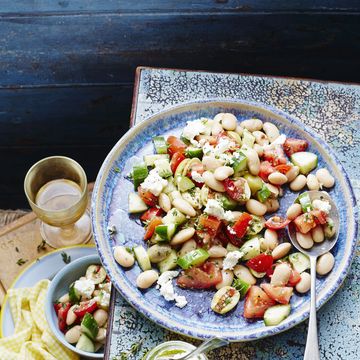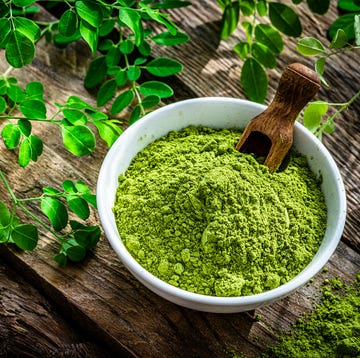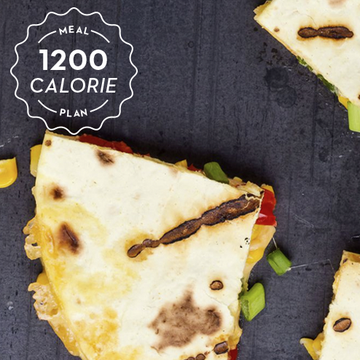If you’re looking for a protein-packed snack, two neighbors in the dairy aisle are great options: Greek yogurt and cottage cheese. Both are excellent sources of the macronutrient, along with calcium and other vitamins and minerals.
Greek yogurt is made the same way regular yogurt is — with milk and live cultures — but then is strained to remove most of the liquid whey, making it thicker and reducing the lactose. “The result is a thick, protein-rich yogurt,” says Jenna Stangland, MS, RD, CSSD, LD, CLT, the director of nutrition for the Minnesota Timberwolves and team dietitian for the Minnesota Wild. “The calcium stays and the probiotics are still present, so it is a nutrient-dense dairy option.”
Cottage cheese is made by adding an acid or rennet to milk to cause milk solids to separate from the whey and then turn into curds. The curds are drained to reduce the liquid content, and salt is added. “Cottage cheese is a good source of high-quality protein, especially rich in casein,” says Michelle Routhenstein, MS, RD, CDCES, CDN, a registered dietitian specializing in heart disease. “Casein is a slow-digesting protein that supports prolonged muscle protein synthesis, satiety and appetite control, making it helpful for weight management.”
You really can’t go wrong with either snack, but is one healthier or better than the other? We asked registered dietitians to weigh in on whether Greek yogurt or cottage cheese wins the top prize.
Greek yogurt vs. cottage cheese nutrition
They're pretty similar, as it turns out. They’re both great sources of protein, calcium and potassium. Protein builds and repairs muscle. Calcium and potassium protect and strengthen bones. Potassium is also an electrolyte that keeps fluids balanced and helps to regulate blood pressure.
They’re both also low in carbs, as long as you stick to plain varieties. While milk does contain some naturally occurring sugars, plain yogurt contains no added sugar.
The nutrition profile of each one varies slightly depending on the manufacturer and on the fat content of the product. There is another key difference that can be a little tricky when comparing the two foods. “One thing to note is serving sizes are a little different,” says Mindy Haar, PhD, RDN, CDN, FAND, the chair of health sciences at New York Institute of Technology. “Cottage cheese is a half-cup. Yogurt is three-quarters of a cup.”
On top of that, there are two important nutritional differences: sodium and probiotics. Greek yogurt doesn’t contain much sodium, but regular cottage cheese has a lot of it. “Choose lower-sodium cottage cheese if you're watching your blood pressure,” Routhenstein says.
Live cultures are needed to make yogurt, so it naturally contains lots of gut-friendly probiotics. Some cottage cheese brands contain probiotics by adding live cultures to their products. (It will say so on the package.)
Here’s how two examples of Greek yogurt and cottage cheese compare:
3/4 cup of plain whole-milk Fage Greek yogurt contains:
- Calories: 160
- Fat: 9 g
- Protein: 15 g
- Carbs: 5 g
- Sodium: 60 mg
- Calcium: 201 mg
- Potassium: 260 mg
1/2 cup of full-fat Good Culture cottage cheese contains:
- Calories: 80
- Fat: 2.5 g
- Protein: 14 g
- Carbs: 5 g
- Sodium: 340 mg
- Calcium: 70 mg
- Potassium: 80 mg
How to choose the healthiest Greek yogurt or cottage cheese
There seem to be a million varieties of both, so how do you pick the best one? Stick to short lists of ingredients, Routhenstein suggests. “Ideally, just milk and live active cultures for yogurt, or milk, cultures and salt for cottage cheese,” she says. “For both, it’s best to avoid flavored varieties, as they often contain added sugars, artificial flavors or unnecessary thickeners that can reduce the overall nutritional quality.” That said, a flavored option can still be worthwhile if it helps you eat these nutrient-dense foods.
What about whole-fat versus non-fat varieties? It depends. The more fat the yogurt or cheese contains, the more saturated fat and calories you’ll need to contend with. On the flip side, more fat also means more omega-3 fatty acids, which are important for heart and brain health. Fat is also more satiating because it takes longer to digest. To help you stay full, opt for a full-fat or low-fat variety instead of non-fat, or add nuts, seeds, or avocado to non-fat versions.
How to eat more Greek yogurt
Thanks to its creamy texture and slightly tart flavor, Greek yogurt can be used in sweet or savory dishes. “If adding it to warm dishes like soups or stews, stir it in after cooking to preserve the live probiotics,” Routhenstein says.
- Sour cream substitute: Dollop it on baked potatoes or tacos. Haar makes a sour cream coffee cake with Greek yogurt.
- Smoothies: Blend into smoothies for added protein and creaminess.
- Parfaits: Alternately layer yogurt with your favorite combo of fruit, granola, nuts, and seeds.
- Mayo replacement: Just about anywhere you use mayonnaise, you can use Greek yogurt instead, like in tuna, egg or chicken salad.
- Dips and dressings: Replace the creamy ranch or dill dressings and dips with ones made with yogurt and herbs. Traditional tzatziki is also made with yogurt.
- Savory veggie bowl: “Make a bowl with plain Greek yogurt, herbs, seasoned chickpeas, cucumber, tomato, onion, dill and whatever else you want to add,” Stangland says.
- Pancakes and waffles: Greek yogurt is a great way to add protein to pancakes and this particular recipe is super freezable so you can make a big batch to thaw as needed.
- Flatbread topping: Spread Greek yogurt on flatbread and then top with salmon and veggies for a tangy, protein-forward meal.
How to eat more cottage cheese
Cottage cheese does actually melt, so it can be a great high-protein, lower-fat swap for Cheddar, mozzarella or other cheeses.
- Quiche: Haar makes a crustless quiche with cottage cheese as the main base.
- Pasta: Use cottage cheese in place of ricotta to power up lasagna, Stangland recommends. Or, try this creamy kale pasta dish.
- Toast topping: Routhenstein likes to spread it on whole-grain toast with sliced avocado and tomato for a quick savory snack or breakfast.
- Pancakes and waffles: “Swap out the milk or cream in your recipe with cottage cheese for a fully protein-rich breakfast choice,” Stangland says.
- Flourless wrap: Mix cottage cheese with eggs and herbs and then bake to create a tasty flourless wrap. Fill it with chicken and veggies for a yummy lunch.
Which one is better?
Both are healthy, high-protein, low-carb foods that are also great sources of calcium and potassium, but Greek yogurt comes out on top. “Overall, both are nutritious choices for heart, bone, and muscle health, with Greek yogurt offering a slight edge due to probiotics, lower sodium, and mineral balance,” Routhenstein says.
But “better” also depends on your individual health profile and goals. Sometimes, choosing the right variety of either one is more of a consideration. “If weight loss is the goal or a risk of heart issues is a concern, go for the skim-milk option to avoid the fat and still get all the other nutritious benefits,” Stangland says.
It also depends on how you plan to use them. Greek yogurt is a good swap for mayo, sour cream or buttermilk in recipes, and cottage cheese can be a healthier sub for other cheeses.
Laura Iu, R.D., is a registered dietitian nutritionist, certified intuitive eating counselor, yoga guide, and owner of Laura Iu Nutrition, a private practice in New York City. She earned her Bachelor of Science in Nutrition and Dietetics from New York University and completed her internship in dietetics at Weill Cornell & Columbia Medical Center of New York-Presbyterian Hospital. She went on to work in New York City’s top hospitals, including Mount Sinai Hospital and NYU Langone Health. She believes that true health is all encompassing — physical, emotional, and mental wellbeing — not an external measure via shape or size.













